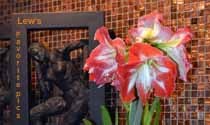 On Wednesday Marianne yelled at me to get my camera. She had spotted a large bird on a fence post in our yard and several more in the field. As I raised my camera to get a shot through the window, several turkey vultures took flight. Outside I found five of them riding the wind higher and higher. As I took a few shots of these birds, I heard the distinct sound of an old prop plane somewhere beyond the trees. Then between the trees I saw a WW II B-17 that was circling towards the Frederick Airport.
On Wednesday Marianne yelled at me to get my camera. She had spotted a large bird on a fence post in our yard and several more in the field. As I raised my camera to get a shot through the window, several turkey vultures took flight. Outside I found five of them riding the wind higher and higher. As I took a few shots of these birds, I heard the distinct sound of an old prop plane somewhere beyond the trees. Then between the trees I saw a WW II B-17 that was circling towards the Frederick Airport. I stopped by the airport as I ran some other errands and found three WW II aircraft parked: a B-24 Liberator, a B-17 flying Fortress and a P-51 Mustang. The planes are part of the Collins Foundation Wings of Freedom tour, a "flying history" tour currently hopping from airport to airport along the east coast.
I stopped by the airport as I ran some other errands and found three WW II aircraft parked: a B-24 Liberator, a B-17 flying Fortress and a P-51 Mustang. The planes are part of the Collins Foundation Wings of Freedom tour, a "flying history" tour currently hopping from airport to airport along the east coast. The B-17G Flying Fortress is one of 14 B-17's still flying in the US. This aircraft was completed in April 1945 and did not see combat, but did see service in air/sea rescue and military air transport. In 1952 the plane was subjected to three nuclear explosions and after a cool down period was sold as scrap. Aircraft Specialties Company restored the plane and it served as a fire bomber, dropping water and borate. In 1986 she was bought by the Collins Foundation and restored to her original wartime configuration by Tom Reilly Vintage Aircraft. The "Nine-0-Nine" designation honors the the 91-st Bomb Group, 323-rd Squadron plane of the same name that flew 140 missions without an abort or loss of a crewman. The original plane was scrapped after the war.
The B-17G Flying Fortress is one of 14 B-17's still flying in the US. This aircraft was completed in April 1945 and did not see combat, but did see service in air/sea rescue and military air transport. In 1952 the plane was subjected to three nuclear explosions and after a cool down period was sold as scrap. Aircraft Specialties Company restored the plane and it served as a fire bomber, dropping water and borate. In 1986 she was bought by the Collins Foundation and restored to her original wartime configuration by Tom Reilly Vintage Aircraft. The "Nine-0-Nine" designation honors the the 91-st Bomb Group, 323-rd Squadron plane of the same name that flew 140 missions without an abort or loss of a crewman. The original plane was scrapped after the war.
Looking up the bomb bay
 The B-24J Liberator is the only restored flying B-24 in the world. This B-24 was built in 1944 and served under the British flag in the Pacific Theater. It was restored by Collins in 1989 and painted with the insignia of the US 15-th Army Air Force. It now carries the insignia of the 8-th Air Force to honor those who served in England in WW II. The original "Witchcraft" B-24 (assigned to the 467 Bomb Group) flew 130 combat missions. After the war the original Witchcraft was scrapped.
The B-24J Liberator is the only restored flying B-24 in the world. This B-24 was built in 1944 and served under the British flag in the Pacific Theater. It was restored by Collins in 1989 and painted with the insignia of the US 15-th Army Air Force. It now carries the insignia of the 8-th Air Force to honor those who served in England in WW II. The original "Witchcraft" B-24 (assigned to the 467 Bomb Group) flew 130 combat missions. After the war the original Witchcraft was scrapped.
50 caliber protection
 The allied bombers needed more protection on the bombing missions into Europe and the P-51 Mustang was developed to fill this need. The P-51 began to accompany the bombers deep into Axis territory in 1942. Nearly 5,000 of these single-seat fighters were built for British and US forces. A few were modified to carry a passenger in a second seat. The Collins P-51 is the only dual-control P-51. The markings and name "Betty Jane" honor Col Charles McCorkle, a P-51 pilot and commander of the 31-st Fighter group in the Mediterranean Theatre.
The allied bombers needed more protection on the bombing missions into Europe and the P-51 Mustang was developed to fill this need. The P-51 began to accompany the bombers deep into Axis territory in 1942. Nearly 5,000 of these single-seat fighters were built for British and US forces. A few were modified to carry a passenger in a second seat. The Collins P-51 is the only dual-control P-51. The markings and name "Betty Jane" honor Col Charles McCorkle, a P-51 pilot and commander of the 31-st Fighter group in the Mediterranean Theatre.









No comments:
Post a Comment